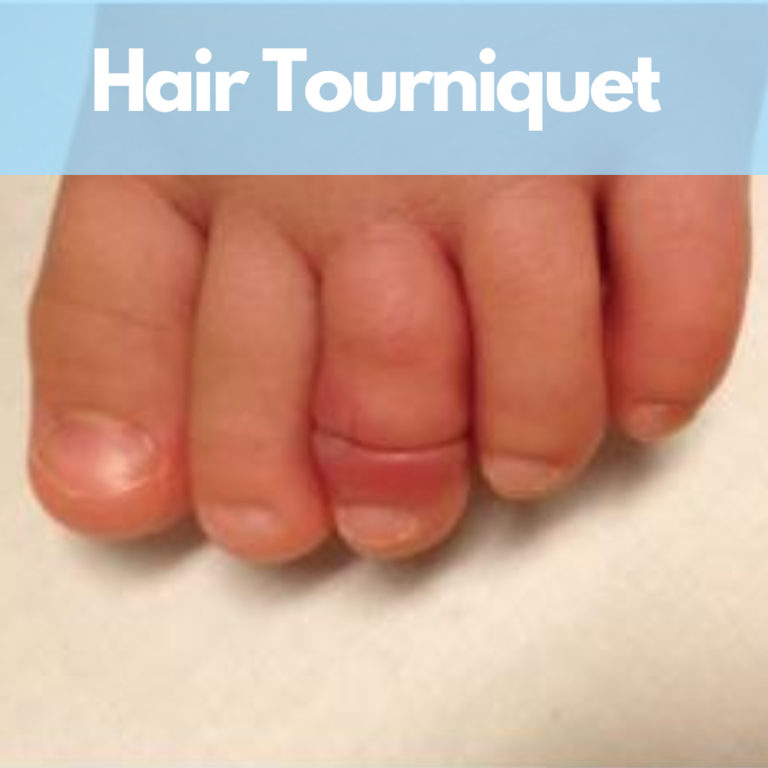
HAIR TOURNIQUET
Share
A hair tourniquet is a piece of hair, a thread from clothing, or a blanket wrapped around a child’s finger or toe. It can also occur on other regions of the body, such as the wrist or ankle. Hair may wrap so tightly that it prevents blood from flowing into the area. This can cause tissue injury.
Sometimes the hair is visible. However, it is sometimes so deep in the skin folds that it is difficult to see.
Redness, swelling, and inconsolable sobbing are among the symptoms. This condition is usually caused by postpartum hair loss, however it is easily curable if detected early.
Symptoms of hair tourniquet
Hair tourniquets are quite painful, thus a baby wearing one will most certainly cry a lot. When it comes to helping a sobbing baby, looking for a hair tourniquet is a unique but vital addition to any parent’s or caregiver’s checklist.
If your child is crying or appears to be in discomfort, and you’ve exhausted the regular feed-change-sleep routine, check the entire body for a hair tourniquet.
Signs and symptoms include:
- red or discolored finger, toe or tongue
- mild to severe swelling in the body
- an indentation or groove on the body, even if no hair is seen.
Hair tourniquets are harmful if they go unnoticed for an extended period of time. Babies are in danger of damaging or losing the affected bodily part. Hair tourniquets may also result in ischemia, which is a lack of blood flow to the affected area.
Hair tourniquets are easily treated if caught early. Immediate medical attention is required to:
- save the attached part
- keep the hair from cutting completely into the skin;
- keep new skin from developing over the hair and embedding it
How to remove a hair tourniquet
The only way to fix a hair tourniquet is to entirely remove the hair. If the area is inflamed or the strand of hair is thin and difficult to notice, this can be challenging.
If you don’t succeed within a few minutes, take your infant to the doctor immediately.
A depilatory cream or another hair removal cream with the active ingredients calcium hydroxide, sodium hydroxide, or calcium thioglycolate may be the simplest approach to remove a hair tourniquet. But only if the skin around the affected area isn’t bleeding or broken should you do this.
After the hair or thread is removed
- Keep the affected area dry. It should not be soaked. When it is safe to get it wet, your doctor will advise you.
- If your doctor has given you instructions on how to care for your child, follow them. If you did not receive instructions, follow the following basic advice:
- After the first 24 to 48 hours, wash the area twice a day with clean water. Avoid using hydrogen peroxide or alcohol, both of which can impede recovery.
- Apply a thin coating of petroleum jelly, such as Baby Vaseline, and a nonstick bandage to the affected area. Replace the bandage as needed with extra petroleum jelly.
- Be cautious when handling medications. Read and obey all label instructions.
- If your doctor recommended pain medication for your child, administer it as directed.
- If your child does not have a prescription for pain medication, ask your doctor if he or she can take an over-the-counter medication.
When should you call for help?
If your child is in new or worse pain, call your doctor right away, or seek immediate medical attention.
- The skin around the affected area is chilly, pallid, or changes color.
- Your child has difficulty moving around the region.
- Your child develops infection signs such as:
o Increased pain, swelling, warmth, or redness in the affected area.
o Red streaks emanating from the area.
o The pus is seeping from the area.
o A high fever.
Preventing hair tourniquets
Hair tourniquets are uncommon, but you should be aware of their potential and take precautions to avoid them:
- Brush your hair on a regular basis to remove any loose hairs that may fall onto your infant.
- Tie back your hair when changing, bathing, or playing with your infant.
- Keep an eye out for signs of hair tourniquet on your baby’s toes and fingers.
- Wearing mittens and washing old clothes with loose threads on a regular basis may increase the danger of a loose thread creating a hair tourniquet.
Have you ever had to witness your baby struggling with a hair tourniquet? Let us know how you dealt with it!
